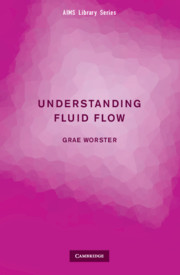6 - Flows around rigid objects
Published online by Cambridge University Press: 30 April 2024
Summary
Irrotational incompressible potential flow
We have shown that if a fluid is truly inviscid, then its flow remains irrotational for all time if its vorticity was once identically zero. Since in that case∇ ×u ≡ 0, there is a scalar velocity potential ϕ such that
Such a velocity field is called a potential flow. If the fluid is also incompressible then ∇ · u = 0, and therefore the potential satisfies Laplace's equation
There is a vast literature on Laplace's equation, much of it associated with electrostatics, where it governs the electric potential in a vacuum, for example. There are many techniques for solving Laplace's equation in different geometries including separation of variables, Green’sfunction techniques, use of analytic complex functions and various integral transforms.
We will explore one or two examples of potential flows to show their use (and limitations) for studying certain types of flow of viscous fluids.
Potential flow past a sphere
Consider the problem of finding the irrotational flow past a rigid sphere of radius a. This problem reduces to solving Laplace's equation in the domain r > a with the boundary conditions
in spherical polar coordinates (r, θ, φ). The first condition says that there is no flow into or out of the sphere. The second condition implies that the flow tends to a uniform stream aligned with the axis θ = 0 far from the sphere.
The general axisymmetric solution to Laplace's equation in spherical polar coordinates can be written as
where the coefficients An and Bn are constants and the Pn are the Legendre polynomials of degree n. Since the Legendre polynomials are orthogonal and the only forcing in the problem is proportional to cos θ = P1(cos θ), the solution must also be simply proportional to P1(cos θ). We therefore observe that the solution to our particular problem has the form
From the far-field condition, as r →∞, we see easily that A1 = 1. The boundary condition on the surface of the sphere is
from which we see that B1 = A1a3/2 = a3/2.
- Type
- Chapter
- Information
- Understanding Fluid Flow , pp. 71 - 82Publisher: Cambridge University PressPrint publication year: 2009

